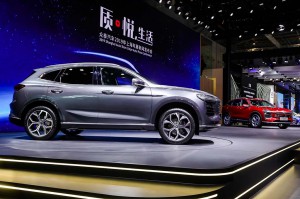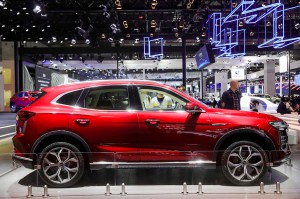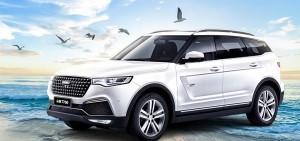At 69, Duke Hale has been selling cars, either at a dealership or working for an automaker, for 50 years, but he’s betting he can become a sort of automotive Pied Piper to Millennials and Gen-Z.
He and a team of aging Baby Boom industry veterans are getting ready to start selling what may become the first cars imported from a local Chinese carmaker. It’s no easy task, his California-based start-up, known as HAAH, is still pitching its idea to the dealers who will have to bet on a brand that’s not only unknown to American car buyers but which is saddled with the ungainly name, Zotye.
Of course, it wouldn’t be the first time U.S. motorists were won over by a brand whose name they’ve had to struggle with. Think Hyundai, which Americanized its name to “Hun-day.” The Chinese brand, pronounced “Zoh-tee,” hopes it can lift some other pages from the Korean carmaker’s playbook, starting with a price low enough to make it an appealing alternative to a used vehicle.
“Think in terms of 20% less than the targeted competition,” notably including the likes of Hyundai, Kia and Toyota, Hale said over dinner at the Renaissance Center in Detroit Thursday night.
(The new Chinese owners of Lotus hope to spark a turnaround. Click Here to learn what they’re planning.)
It’s an ironic location considering the complex is home to General Motors which is one of only two automakers currently importing vehicles from China – the other being Volvo. There are, by various estimates, as many as 200 local car companies in China, though only a few produce any real volume. Over the past decade, domestic leaders like BYD, GAC and Great Wall have announced plans to set up their own dealer networks in the U.S. So far, not one has made it across the Pacific.
But Hale is convinced his start-up – an independent importer in which he is majority owner – can succeed where those others have faltered. It helps that he and his senior team, including marketing chief Jan Thompson and sales director Bob Pradzinski, have spent decades in the business, mostly working for import brands, like Hyundai, Mazda and Toyota, that also had to figure out how to crack open the door to the lucrative American market.
Pricing is clearly going to be a key to success, said Thompson, who joined Hale and Pradzinski for dinner. The cost of a typical American new vehicle has surged to a record of around $35,000, according to industry data, with monthly payments averaging $550 a month. She believes Zotye will come in around $150 less when it fleshes out its product line-up.
The plan calls for it to launch its first entry, the T600 sport-utility vehicle late in 2020 or early 2021. Zotye debuted the new model, which targets the likes of the Toyota RAV4, at the Shanghai auto show last month to positive reviews. A midsize SUV is expected to follow a year later, with a big, three-row ute on tap for 2022 or 2023. Initially, all those products will be powered by a 1.6-liter turbo-four engine, but HAAH wants to add at least one all-electric model later in the decade.
Zotye itself recently entered a nearly $1 billion joint venture with Ford Motor Co. to develop a new range of battery-electric vehicles that Ford would market in China. HAAH might be able to tap one of those for the States.
Despite its low price, Hale insisted his Chinese-made vehicles will deliver significant profit margins for both the U.S.-based importer and its dealers. That’s a significant selling point for retailers considering that they currently lose an average $331 for every new vehicle they sell, according to data from the National Automobile Dealers Association, clawing back into the black by selling insurance and financing, as well as service work.
To further attract dealers, Hale said his company will no longer require “Taj Mahals,” the fancy and expensive showrooms that are typically required by entrenched auto brands. Think something closer to Costco, he suggested.
HAAH also is lifting a couple pages from the old Saturn strategy. It plans to use a “no haggle/no hassle” approach to pricing. And dealers will be offered large geographic franchises in which they could set up multiple outlets. That could include showrooms in malls, something Tesla has done – though there won’t be any factory stores. Meanwhile, the company expects to do a sizable share of its business online, though it plans to credit sales to individual dealers who will get full commission.
So far, the Zotye operation has lined up 60 sales points in 15 states, with somewhere north of 20 dealers in the process of coming onboard, Pradzinski claimed.
(Chinese-owned Volvo takes a Q1 hit to earnings. Click Here for more.)
Despite the fact that the members of the senior HAAH management team are in the 50s and 60s, they are betting they can appeal to the youngest of U.S. car buyers by offering an extremely flexible buying process. It will also be a simpler process, the start-up planning to offer just two grades of each new product, a choice of front- or all-wheel-drive, and five colors. Thompson says they will also be heavily loaded with high-tech features young buyers like, including a range of advanced driver assistance systems.
But ultimately, said Thompson, price is likely to be the real turn-on. “I tell my neighbors in Tennessee I’m going to sell a Chinese car and they all say they’re not interested,” she said. “Then I tell them the price and they all ask where they can sign up.”
There are a few other issues that HAAH could face. That includes the ongoing trade dispute between the U.S. and China. Hale is convinced a settlement is imminent but, even if Pres. Donald Trump ordered new tariffs, he confided, there is so much profit built into the Zotye vehicles an added 15, even 25% wouldn’t shake the plan by much.
This isn’t the first time a U.S.-based importer launched a brand based on foreign-made vehicles. A similar approach was used with several Japanese brands in their early years, including Mazda, Subaru and Toyota.
Meanwhile, Hale said over desert, the approach gives HAAH flexibility to expand. “There are probably more brands to be announced in the future,” he hinted, declining to offer details. But there are plenty of Chinese domestic automakers that are trying to figure out how to crack into the American market, and if HAAH can make it work for Zotye it could make a case to other export wannabes.
(Faraday Future gets rescued, again. Click Here for the latest on the Chinese-founded EV company.)



